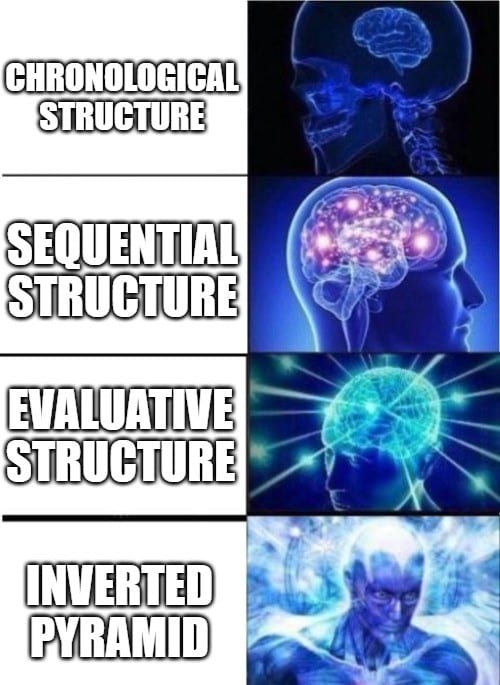
Structure an Great Press Release with The Inverted Pyramid
Your press release will benefit from having the most important information at the top. Even if your readers don’t read everything, they’ll have consumed the main point, at least! Save the flowery prose; the inverted pyramid is ideal for busy readers.
The inverted pyramid is a method of structuring a press release that puts the most important information first. While most writers are familiar with the standard intro, body, and conclusion, the inverted pyramid is the opposite. Start with who, what, where, why, and when. Then follow it up with supporting and background information. It’s much different than, for example, an essay, where writers will start with an intro that sets the stage for the main thesis. This is usually followed up by a conclusion, which summarizes the main findings of the piece.
Why the name? Well, any structure’s most important feature is its foundation. Think of a pyramid, then flip it upside down. With the inverted pyramid, we’re placing the most important parts at the top.
This style of writing gets straight to the point and benefits all kinds of readers. Professionals are busy and benefit from objective, succinct writing. Even if they don’t get through your content in its entirety, the inverted pyramid ensures they get the gist of it. Editors also benefit; if the piece needs trimming, they know that the less important information is further down the page and cut as needed.

But Why the Inverted Pyramid?
The inverted pyramid is perfect for writing on the internet, whether on desktop or mobile. People’s attention spans are shorter than ever. If they aren’t engaged at the start, they most likely won’t make it through to the end. The inverted pyramid addresses this head-on by starting with the most pertinent information.
Utilizing the inverted pyramid in your press release writing can:
- Ensure your story gets read: Readers short on time get the main part of the story, even if they don’t read the whole piece.
- Encourage scrolling: When the main point is at the start, readers can decide whether they are genuinely interested in the content. If so, they can simply scan and scroll for the specific details they’re looking for.
- Improve SEO: The most relevant keywords will be right alongside where the most important information is—at the top.
- Get people’s attention: Start with the good stuff. Verbose intros can do more harm than good in this context. It’s not a college application essay.
How to Set Up Your Inverted Pyramid
- Determine the story. In plain English, what is the story you want to tell? Start with the who, what, where why, and when.
- Identify the secondary information. All the bells and whistles your product has to offer? Company history? That goes further down. (I don’t need to know how the Scrub Daddy works to know it’s my favorite sponge.)
- Be objective. By focusing on facts, you can avoid being too salesy. Being aggressive with how great your products/services are can turn people off bigly.
- Each paragraph should be its own inverted pyramid. Say only what needs to be said. The first sentence is the main idea. Everything else that follows should support that main idea with relevant information.
- If there are some features, bells, and whistles you want to include, consider a bulleted list. Bullets also improve scannability and emphasize what you want people to know.
- Have a quote you want to include? Put that near the top. In many cases, quotes are time-sensitive, unique to a specific piece, and come from someone with authority. That makes them more important than evergreen details that can be found on product pages or brochures.
Conclusion
The inverted pyramid sets up your press release for easy consumption. Structuring your release with the most important information facilitates understanding and improves clarity.
Too often, business owners want to list every benefit, every use case, and every new feature of a new product at the start. This muddles your content and obscures the more important parts of the story. Sticking with the inverted pyramid will help you engage and inform people more effectively.











